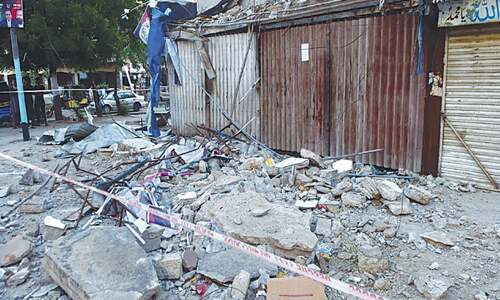KARACHI: Once a magnificent fortified enclosure that had served its people well, particularly during conflicts, the Kalankot fort located behind the under-construction Thatta district jail in Makli is not even a shadow of its former self.
Worse still is to see the extensive remains of the historical fort open to public vandalism as the tiles of the only remaining dilapidated structure at the site are gradually disappearing, a visit to the site showed.
The site offers no clue to the visitor about its name and glorious past as there is no signpost or guide there to provide such details. A board, one finds there, has been whitewashed for some unknown reasons.
A large area covered with burnt bricks, a crumbling building, perhaps of a mosque and a masonry tank leaves a visitor guessing about the site’s exact background. One could, however, gather a lot of information about the fort from books and old journals.
“Kala Kot or Kalan Kot (correctly Kalyana Kot that means the fort of recreation, security or prosperity in Sanskrit) is also known as Tughlaqabad after the name of the Samma ruler Jam Tughlaq bin Sikandar Shah (1427-1453 AD) who is credited to have carried out some repairs to the fort.
“It is also known as Tughrilabad after the name of Mughal officer Tughril Beg who is lying buried in a tomb pavilion south of the Tomb of Isa Khan II (at Makli Hill),” writes late archaeologist and historian Prof Ahmad Hasan Dani in his book Thatta: Islamic Architecture.
The fort, according to him, played a role during the hard days of the Arghun rulers and also in struggle between Jani Beg Tarkhan and the Mughal commander Abdur Rahim Khan-i-Khanan. But, so far there is no evidence of the Hindu origin of the fort. The type of brick masonry and the round towers used in the fort reveal its Muslim origin.
“It is quite possible that the foundation of the fort was laid in the late Sumra period, sometime towards the close of the 12th century A.D,” he writes.
There are other perspectives, too, though. For instance, giving a reference to Tarikh-i-Masumi, former deputy director of provincial archaeology department Khan Mohammad in the List of Protected Sites and Monuments writes that the fort was said to have been constructed by Mirza Jani Beg somewhere in the last quarter of the 16th century A.D on the site of an earlier fort built by Jam Taghur or Taghlik on the site of a still earlier Hindu fort.
“Mirza Jani Beg while fighting with emperor Akbar’s troops under Khan Khanan wrote to his father Payndah Beg and his son Abul Fateh who were at Thatta to construct a fort as a place of refuge should he be compelled to flee before the enemy.
“He further desired that, under such circumstances, the city of Thatta should be abandoned to its fate and they should take themselves along with people to Kalan Kot.”
‘Part of Makli heritage’
Upon contact, former secretary of the Sindh antiquities department Dr Kaleemullah Lashari said that the fort was not just protected under the antiquities and heritage acts but was also part of the Makli Hill that had the status of Unesco (United Nations Educational, Scientific and Cultural Organisation) World Heritage Site.
“It was built by Samma rulers in the 14th century. It’s part of the Makli world heritage. Unfortunately, more than half portion of Makli on the southern side could never attract official attention,” he pointed out.
Unesco, he said, had repeatedly wrote to the government for the upkeep of the Makli Hill but officials were yet to move.
Director Qasim Ali Qasim of the archaeology department said that the signboard at the historical ruin was uprooted by flood victims in 2010.
A plan of about Rs333 million, however, had been approved for conservation of 130 historical sites across Sindh.
“Historical sites are in poor shape because of decades’ of neglect when the department was under the federal government and received a meagre budget. After devolution, things have changed. Right now, we are awaiting funds’ release so the process of repair and maintenance of historical sites could start,” he added.













































Dear visitor, the comments section is undergoing an overhaul and will return soon.